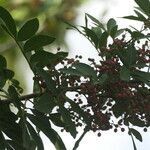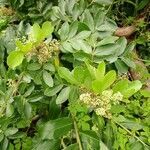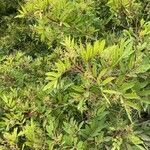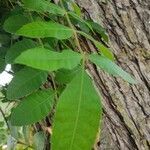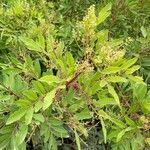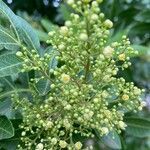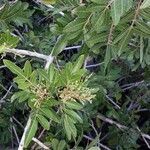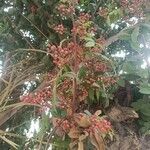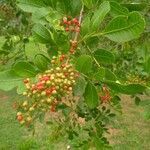Shrub or tree to 7 m high, the branches glabrous or pubescent on young portions. Leaves imparipinnate, with 1-6 pairs of opposite leaflets, the rachis 3-14 cm long and often winged, the leaflets sessile or with petiolules to 1 mm long; lamina of leaflets obovate or elliptic to oblong or oblong-lanceolate, apically acute to rounded or rarely emarginate, occasionally mucronulate at the apex, basally cuneate, 1.5-7.5 cm long, 0.7-3.2 cm broad, having a length/width ratio of 1.3/1 to 3/1, entire or serrate, glabrous to conspicuously pilose, darker and often lustrous above, thickly membranous or subcoriaceous, the secondaries apparent, the reticula-tion obscure or subobscure. Inftorescences paniculate to subracemose, axillary, 1-11.5 cm long, conspicuously hirsute to glabrate. Flowers male or female (a pistillode present in male flowers, staminodes present in female flowers), the pedicels 0.5-3 mm long; calyx-segments 5, deltoid, ca 0.75 mm long, often ciliate marginally; petals 5, ascending, oblong to ovate, apically rounded or subtruncate, white, 1.2-2.5 mm long, often curled outward at the tip; stamens 10, the anthers ovate and 0.5-0.8 mm long in male flowers, the filaments compressed-subulate; disc 10-crenulate; ovary subglobose, ca 1 mm long, the ovule subapical, the style apparently single (the 3 styles confluent), 0.2-0.3 mm long, the stigmas 3, flattended, capitate. Drupes red, 4-6.5 mm long and broad.
More
Shrub or tree to 7 m high; branchlets not pendulous. Leaflets 7–13, mostly 9, sessile, opposite, obovate or elliptic, obtuse, entire or serrulate-crenulate, 1.5–5 cm long, 1–3 cm wide; base obtuse; secondary veins 7–14 pairs. Inflorescence an axillary panicle, puberulous; pedicels 0.7–1 mm long. Sepals broadly ovate, glabrous or sparsely puberulous, c. 0.7 mm long. Petals ovate, obtuse, glabrous, c. 1.3 mm long. Male flowers: anthers 0.5 mm long; filaments alternately 0.8 mm and 1.4 mm long; disc saucer-shaped. Female flowers: staminodes c. 0.5 mm long; disc cup-shaped; ovary subglobular; styles 0.2 mm long. Drupe c. 5 mm diam., red. [See also Green 1994: 245.]
"A weed of subtropical, tropical and warmer temperate regions, particularly in areas near habitation. It is found along waterways and roadsides, in urban bushland, open woodlands, disturbed sites, waste areas and coastal wetlands." Queensland Government (2016). Can compete with regeneration of native species.
More
Moist lowland scrub. Found in a range of forest types, usually in secondary growth formations, favouring moister sites such as river banks and ditches, but also found in poor dry soils. Sands of the littoral.
